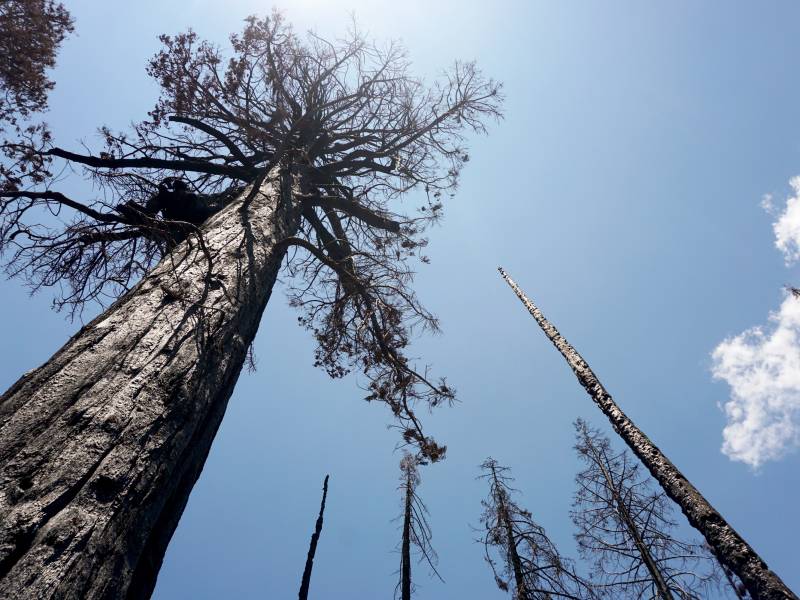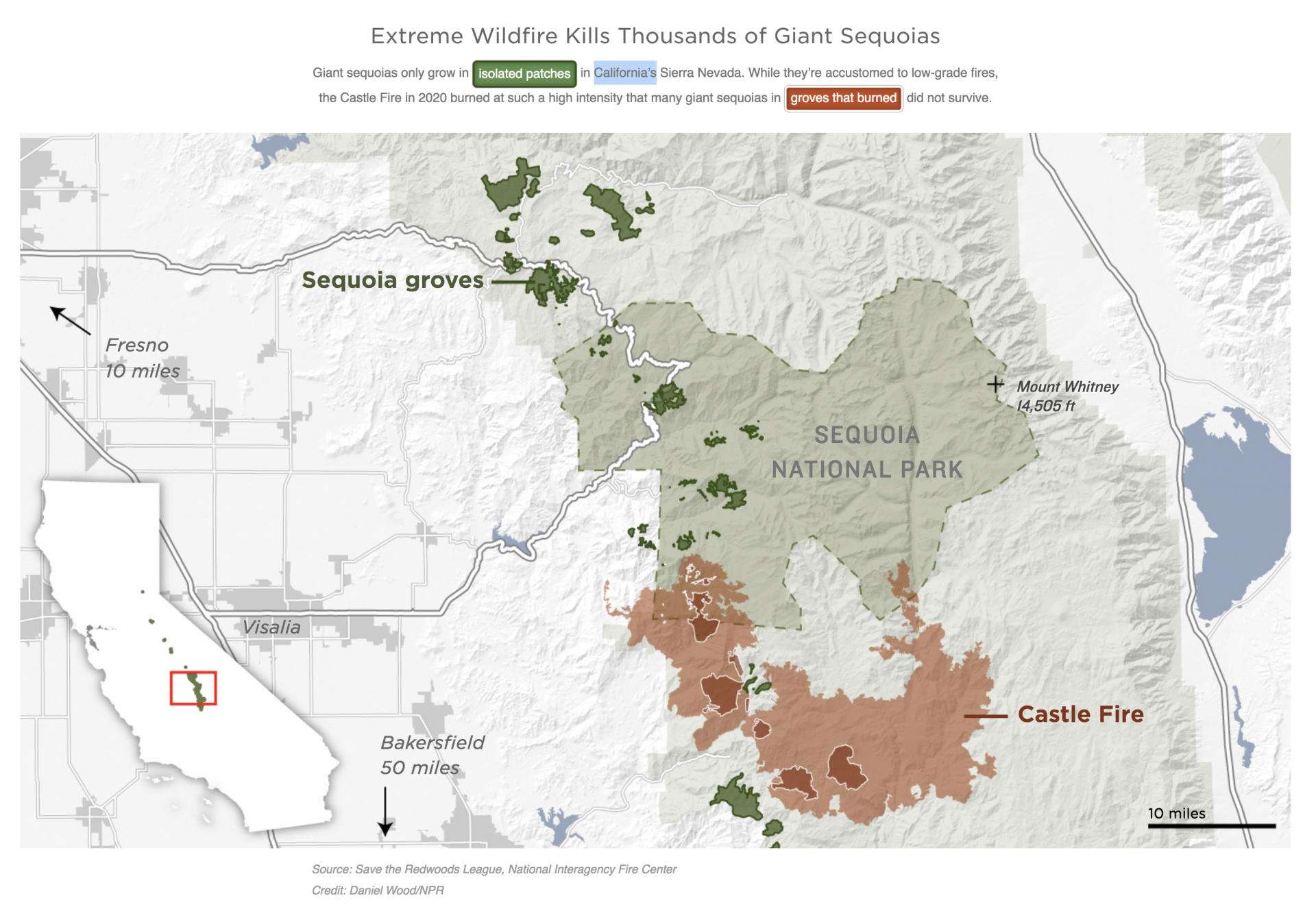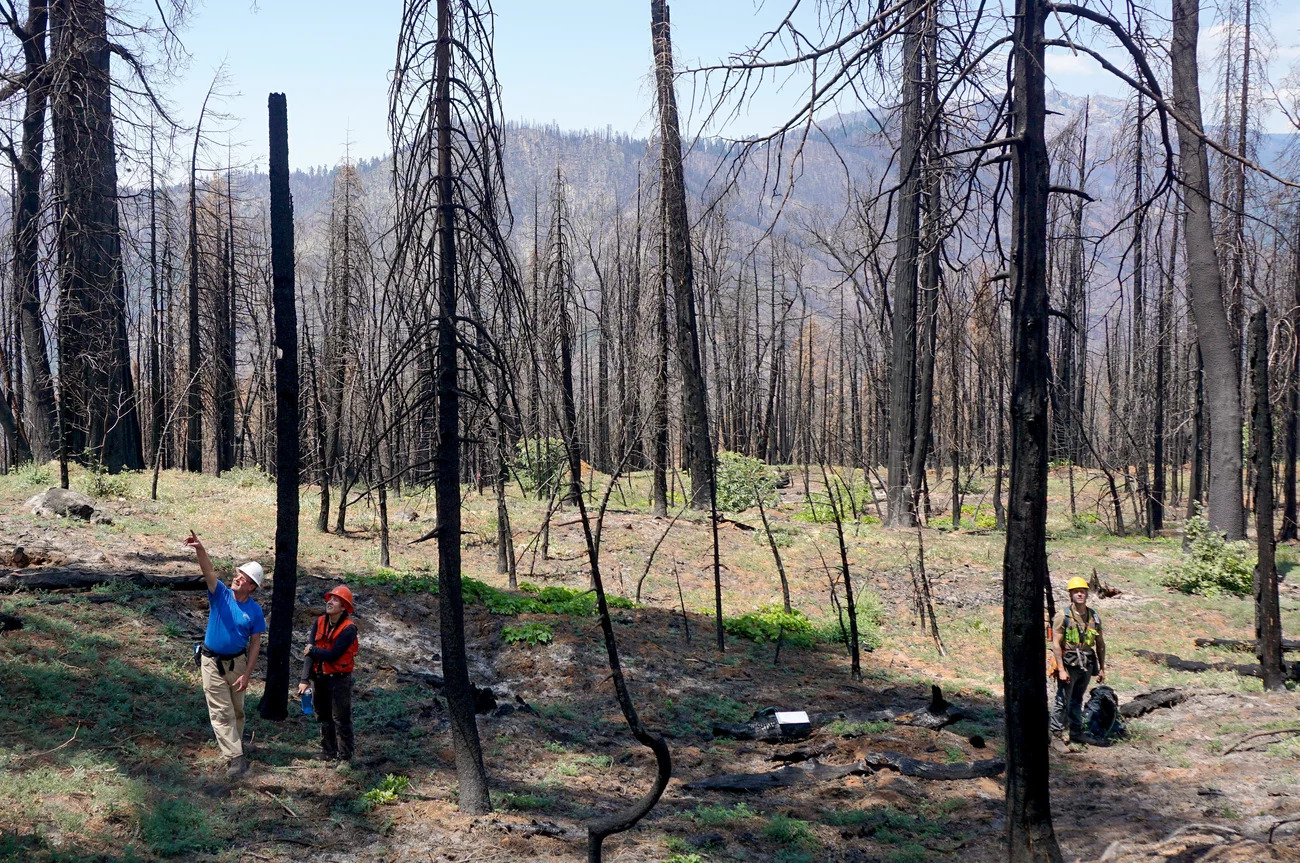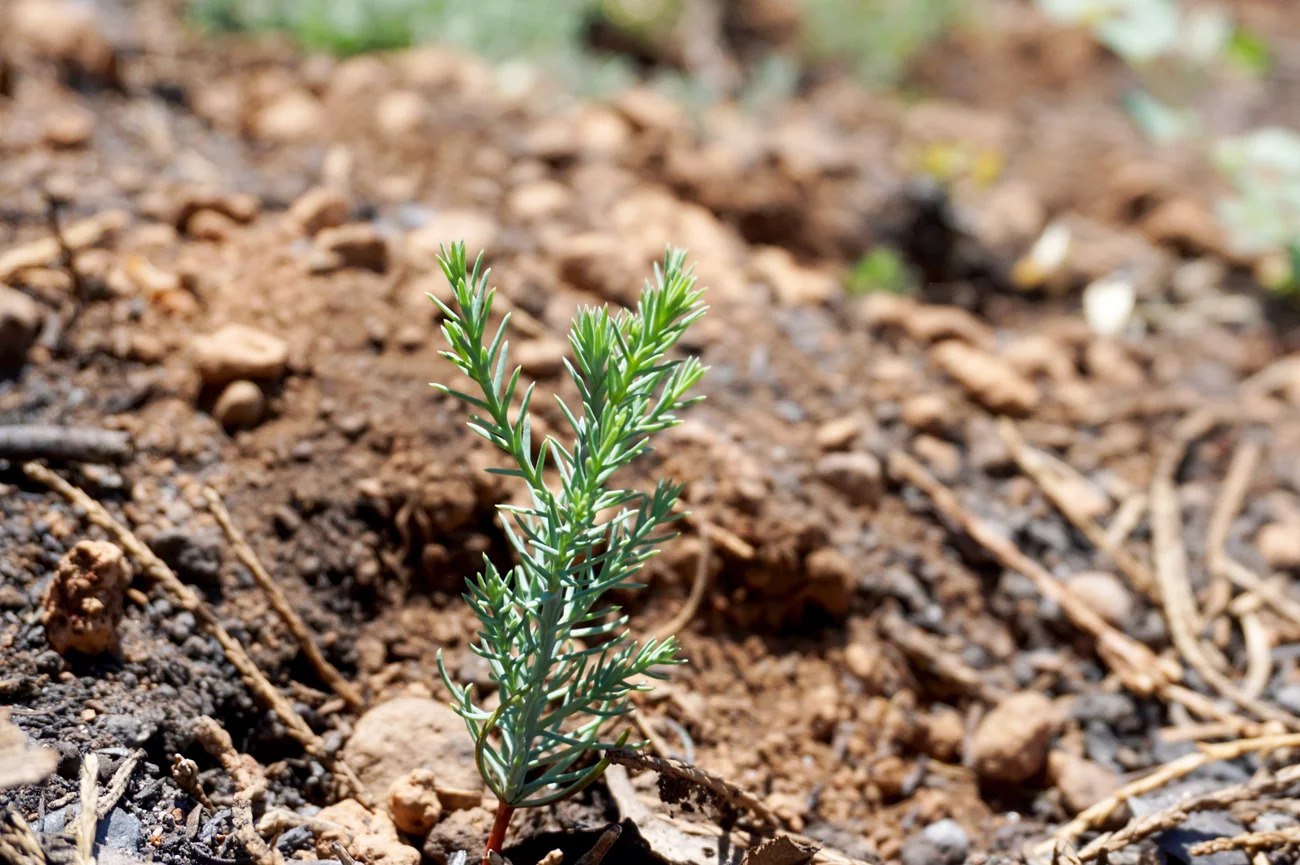On a hot afternoon in California’s Sequoia National Park, Alexis Bernal squints up at the top of a 200-foot-tall tree.
“That is what we would call a real giant sequoia monarch,” she says. “It’s massive.”

On a hot afternoon in California’s Sequoia National Park, Alexis Bernal squints up at the top of a 200-foot-tall tree.
“That is what we would call a real giant sequoia monarch,” she says. “It’s massive.”
At 40 feet in diameter, the tree easily meets the definition of a monarch, the name given to the largest sequoias. It’s likely more than 1,500 years old.
Still, that’s as old as this tree will get. The trunk is pitch black, the char reaching almost all the way to the top. Not a single green branch is visible.
“It’s 100% dead,” Bernal says. “There’s no living foliage on it at all.”
The scorched carcasses of eight other giants surround this one in the Alder Creek Grove. A fire science research assistant at UC Berkeley, Bernal is here with a team cataloguing the destruction.
It’s not easy to kill a giant sequoia. They can live more than 3,000 years and withstand repeated wildfires and droughts over the centuries.
Now, with humans changing both the climate and the landscape surrounding the trees, these giants face dangers they might not survive.
Last year, the Castle Fire burned through the Sierra Nevada, fueled by hot, dry conditions and overgrown forests. Based on early estimates, as many as 10,600 large sequoias were killed — up to 14% of the entire population.

“This is unprecedented to see so many of these large old-growth trees dead, and I think it’s a travesty,” says Scott Stephens, fire scientist at UC Berkeley, as he surveys the damage. “This is pure disaster.”
With extreme fires increasing on a hotter planet, scientists are urgently trying to save the sequoias that remain. Researchers from federal agencies and universities are teaming up to find the sequoia groves at highest risk. The hope is to make them more fire-resistant by reducing the dense, overgrown vegetation around them before the next wildfire hits.
But now, one year later, the sequoia groves again are under threat. At the time of publication, wildfires burning in Sequoia National Park were within a mile of a grove with thousands of sequoias. Firefighters are battling to contain the blazes.
“It’s hard to see these trees that have lived hundreds to potentially thousands of years just die,” Bernal says, “because it’s just not a normal thing for them.”
Giant sequoias only grow in isolated pockets, tucked in the mountains of California. Losing even a few groves spells significant loss to the entire population.
Sequoias are one of the most fire-adapted trees on the planet. With tough, foot-thick bark, they’re insulated from the heat. They tower above the rest of the forest, and the bottom of the tree trunk is bare, without low branches that might be ignited by trees burning around it.
Old-growth sequoias weathered the low-intensity wildfires that were once the norm in the Sierra Nevada. Fires regularly spread along the forest floor, either ignited by lightning or set by Native American tribes who used burns to shape the landscape and cultivate food and materials.
With the arrival of white colonizers, fire began to disappear from these forests. Tribes were forcibly removed from lands they once maintained, and federal firefighting agencies mounted a campaign of fire suppression, extinguishing blazes as quickly as possible.
That meant forests grew denser over the last century. Now, the built-up vegetation has become a tinder box, fueling hotter, more extreme fires, like the Castle Fire, that kill vast swaths of trees.
“These trees have been here 1,500 years, so how many fires have they withstood? Eighty?” Stephens says. “And then one fire comes in 2020 and suddenly they’re gone.”
 The Castle Fire’s fierce heat was also fueled by the changing climate. In 2012, when a drought hit California, hotter temperatures amplified the toll it took on Sierra Nevada forests. While the largest sequoias could handle it, other kinds of conifers around them succumbed. Millions of trees were killed.
The Castle Fire’s fierce heat was also fueled by the changing climate. In 2012, when a drought hit California, hotter temperatures amplified the toll it took on Sierra Nevada forests. While the largest sequoias could handle it, other kinds of conifers around them succumbed. Millions of trees were killed.
“The extra warmth that came with the drought pushed it into a whole new terrain,” says Nate Stephenson, an emeritus scientist with the U.S. Geological Survey. “That’s what really helped kill a lot of trees, and they became fuel for fires.”
During his four decades of studying the trees, Stephenson had rarely seen an old-growth sequoia die. When the first images emerged after the Castle Fire hit, he wasn’t prepared.
“That’s when I couldn’t help it,” he says. “I don’t cry often, but I cried when I saw the photos. Because I love these trees.”
A year later, the soil is still powdery black in the Alder Creek sequoia grove. The UC Berkeley team is scanning it for signs of hope: any spot of green.
“Two tiny sequoias here growing from the regeneration from the fire,” Stephens says, finding 2-inch-tall seedlings, impossibly tiny compared to what they could become.
The life cycle of a sequoia hinges on wildfire, which is the trigger for releasing its seeds. The blast of heat opens the cones, sending a shower of seeds to the forest floor, which get established quickly on the newly cleared ground.
In some groves, researchers are finding hundreds of seedlings where the Castle Fire burned with low intensity, more like the kind of fire sequoias are accustomed to.
But in the Alder Creek Grove, where the fire burned with ferocious heat, the team only finds a dozen seedlings the entire afternoon. Other groves look similarly bare.
Even under normal conditions, around 98% of sequoia seedlings die in their first year. This year could be even tougher, with extreme drought gripping the landscape.
“I am very concerned that some areas will not have sequoias,” says Christy Brigham, head of resources management and science for Sequoia and Kings Canyon National Parks. “All the adults are killed and there will not be enough seedlings to repopulate.”

That’s leading land managers to consider planting new sequoias, so the scorched groves don’t disappear entirely. But in a changing climate, it’s not a simple question. As temperatures rise, young trees planted today face surviving in a vastly different future. The most suitable habitat for sequoias could move somewhere else.
“That is one of the gifts of giant sequoias … that they force us to think in deep time,” says Brigham. “It forces us to confront the challenge of climate change.”
Federal land managers say that given the millennia-length time frame, planting new sequoias is a back-up plan at this point. The more pressing need is saving the trees that are left.
The Giant Sequoia Lands Coalition, a partnership of the National Park Service, the U.S. Forest Service, universities, local Native American tribes and nonprofits, is identifying the groves most at risk and this summer has been rapidly assessing conditions on the ground.
“We just saw what one wildfire did,” Brigham says. “Can we find the places, do the plans, and get the funding and put the people on the ground fast enough to prevent loss like this in the future?”
Brigham estimates around 40% of the sequoia groves on national park land alone are at risk of severe wildfires, because the surrounding forests haven’t burned in decades. Other groves at risk are found on Forest Service or private land.

Sequoia National Park has used controlled burns, also known as prescribed fire, since the 1960s to prevent forests from becoming overgrown. But Brigham says burning continues to be a challenge.
In the spring, when cooler conditions are better for controlled burns, projects are limited because of the threatened pacific fisher. The slender, mink-like animal was listed as endangered in 2020, and its habitat is protected during the spring denning season.
But burning in the summer can be tough because of air quality concerns, extremely dry vegetation or lack of personnel.
“There are all these constraints on prescribed fire that we can’t control,” Brigham says. “As it gets hotter and drier, that window is smaller and smaller.”
Brigham says she’s hopeful that land managers can move quickly over the next year to prioritize the sequoia groves that need help the most. With extreme fires becoming increasingly common, time is running short.
“It is not too late,” says Brigham. “We can do better. People love these trees. So I just hope we can take that love and translate it into immediate action to protect the groves and long-term action to limit climate change and its impacts.”
9(MDAxOTAwOTE4MDEyMTkxMDAzNjczZDljZA004))

To learn more about how we use your information, please read our privacy policy.